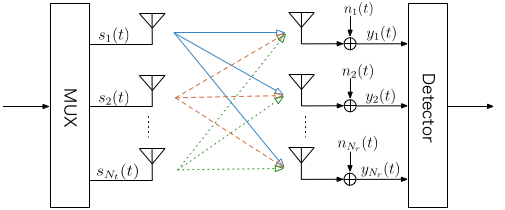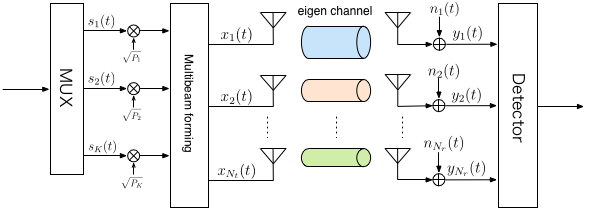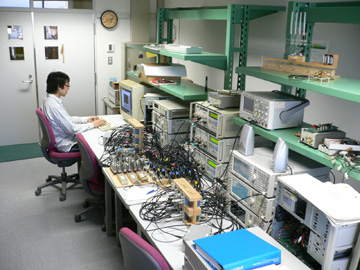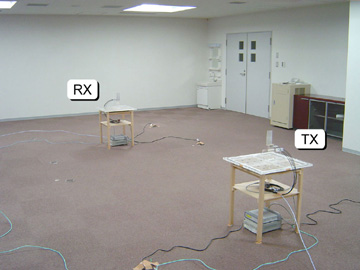MIMO空間多重
MIMO (Multiple-Input Multiple-Output) とは、送信側と受信側の双方に複数のアンテナを設置して伝送を行うシステムです。このMIMOシステムは、従来信号劣化の要因であったマルチパスを積極的に利用することで伝送効率を高める技術であり、今後無線通信を行う上で重要な技術として1990年代後半に登場して以来、世界中で盛んに研究されています。
MIMOシステム上で行う伝送には様々な方式が提案されています。中でも、伝送品質を高める時空間符号化 (Space-Time Coding: STC) と、伝送速度を向上させる空間多重方式 (Spatial Multiplexing) は研究が盛んです。当研究室では、主に空間多重方式に重点を置いて研究を行っています。MIMO空間多重は、送信アンテナ数に応じて複数の情報信号 (ストリーム) を同時に送信することにより、空間的にストリームを多重化して伝送する方式です。このMIMO空間多重方式は、送信アンテナ毎にストリームを送信する方式と、送信ビーム毎にストリームを送信する方式の二つに大きく分けることができます。前者は空間分割多重 (Space Division Multiplexing: SDM) 方式と呼ばれ、後者の代表的なものは固有ビーム空間分割多重 (Eigenbeam-Space Division Multiplexing: E-SDM) 方式です。両方式について簡単な図を下に示します。SDM方式はSDMAとほぼ同じ概念に基づいており、各送信アンテナから独立な信号を送信し、受信側ではスマートアンテナにより多重化された信号を分離・検出します。一方、送信側で伝搬路 (チャネル) 状況に関する情報が得られている場合、予め送信信号に、受信側で分離しやすいように、かつ、ストリーム品質を高めるように重みを付けて信号を伝送することが可能となります。つまり、送信側でもスマートアンテナ処理を行います。中でも、E-SDMは空間的に直交した最適なストリームを形成する方式で、ストリーム同士が互いに干渉することなく受信側に信号を伝送することができます。
SDM方式は、送信側での制御が簡易であるため、E-SDM方式に比べて送信側の負担を小さくすることができます。しかし、E-SDM方式を用いた場合は、各ストリームが直交しているため受信側で容易に信号の分離ができ、理論的には最大の通信容量を得ることができます。
MIMO Spatial Multiplexing
A multiple-input multiple-output (MIMO) system is a transmission system equipped with multiple antennas both at the transmitter and receiver. It improves transmission efficiency by aggressively exploiting multipath which has been thought of as a factor of signal deterioration, and there has been an increase of research on it as one of the core technologies for future wireless communications all over the world since it appeared in the late 1990s.
Various transmission techniques have been proposed and studied in a MIMO system. In particular, "space time coding (STC)" for higher transmission quality and "spatial multiplexing (SM)" for higher data-rate transmission are the hottest topics among them. Our laboratory mainly focuses on SM. In MIMO-SM, the transmitter spatially multiplexes multiple data substreams by simultaneously transmitting the substreams in parallel according to the number of transmit antennas. The MIMO-SM can be roughly classified into two types: substream transmission per transmit antenna and substream transmission per transmit beam. We refer to the former as "space division multiplexing (SDM)," and a typical case of the latter is "eigenbeam-space division multiplexing (E-SDM)." Simple concepts of both two schemes are shown below. SDM is based on almost the same concept as SDMA; the transmitter sends an independent signal substream from each transmit antenna, and the receiver demultiplexes the received signal by a smart antenna technique. On the other hand, if the transmitter knows the channel state information (CSI), it can weight the transmitted substreams in advance so as to make it easier for the receiver to demultiplex the received signal and to improve the received substream quality. In other words, it is possible also for the transmitter to perform smart antenna processing. In particular, E-SDM is the optimum transmission that enables us to transmit substreams via spatially orthogonal beams, so that the receiver can demultiplex the received signal without any inter-substream interference.
In SDM, since the transmit control is easier than E-SDM, we can reduce the computational load at the transmitter. On the other hand, E-SDM is the optimum transmission in a MIMO system so that theoretically we can obtain the maximum channel capacity.

SDMの概念図
Concept of SDM.

E-SDMの概念図
Concept of E-SDM.
上述したように、MIMOシステムはマルチパスを有効利用する技術です。一方、伝送周波数帯を効率的に使用できるOFDMは、マルチパス対策として有用な手法です。この二つを組み合わせたMIMO-OFDMは、マルチパス環境において飛躍的に伝送効率を高める手法として盛んに検討されており、既に次世代の無線LAN等での必須技術として期待されています。
当研究室では、空間多重時の受信機におけるストリーム検出法や、MIMO-OFDMに特化したチャネル推定法、E-SDMにおける送信ビーム及びリソース制御法等について研究を行ってます。また、それらについて、独自の実験システムを用いた検証実験も行っています。
As stated above, a MIMO system is a technique beneficially using multipath. On the other hand, OFDM is an effective countermeasure to multipath because it can efficiently use the given frequency band. The system combining these two techniques, or MIMO-OFDM, has been extensively studied as a promising way to significantly improve transmission efficiency in multipath environments, and is already one of the core technologies for next wireless fields such as wireless LAN.
In our laboratory, studies on substream detection schemes in SM, channel estimation schemes specialized on MIMO-OFDM, schemes controlling transmit beams & resource allocation in E-SDM, etc., have also been advanced. We also conduct MIMO experiments using our own systems to examine the proposed schemes in practice.

MIMOテストベッドを用いた伝送実験
Transmission experiment using a MIMO testbed.

屋内MIMOチャネル測定
Indoor MIMO channel measurement.
[文献]
大鐘, 西村, 小川, "MIMOチャネルにおける空間分割多重方式とその基本特性," 信学論B, vol. J87-B, no.9, pp. 1162-1173, Sept. 2004.
Y. Ogawa, K. Nishio, T. Nishimura, and T. Ohgane, "Channel Estimation and Signal Detection for Space Division Multiplexing in a MIMO-OFDM System," IEICE Trans. Commun., vol. E88-B, no. 1, pp. 10-18, Jan. 2005.。
宮下, 西村, 大鐘, 小川, 鷹取, 長, "MIMOチャネルにおける固有ビーム空間分割多重 (E-SDM) 方式," 信学技報, vol. 102, no. 86, RCS2002-53, pp. 13-18, May 2002.
内藤, 西村, 大鐘, 小川, "適応変調制御E-SDM通信のテストベッドによる検証実験," 信学技報, vol. 107, no. 262, RCS2007-83, pp. 19-24, Oct. 2007.。
H. Nishimoto, Y. Ogawa, T. Nishimura, and T. Ohgane, "Measurement-Based Performance Evaluation of MIMO Spatial Multiplexing in a Multipath-Rich Indoor Environment," IEEE Trans. Antennas and Propag., vol. 55, no. 12, pp. 3677-3689, Dec. 2007.
[Reference]
T. Ohgane, T. Nishimura, and Y. Ogawa, "Applications of Space Division Multiplexing and Those Performance in a MIMO Channel," IEICE Trans. Commun., vol. E88-B, no. 5, pp. 1843-1851, May 2005.
Y. Ogawa, K. Nishio, T. Nishimura, and T. Ohgane, "Channel and Frequency Offset Estimation for a MIMO-OFDM System," IEEE VTC2004-Fall, vol. 2, pp. 1523-1527, Sept. 2004.
K. Miyashita, T. Nishimura, T. Ohgane, Y. Ogawa, Y. Takatori, K. Cho, "High Data-Rate Transmission with Eigenbeam-Space Division Multiplexing (E-SDM) in a MIMO Channel," IEEE VTC2002-Fall, vol. 3, pp. 1302-1306, Sept. 2002.
H. Nishimoto, Y. Ogawa, T. Nishimura, and T. Ohgane, "Measurement-Based Performance Evaluation of MIMO Spatial Multiplexing in a Multipath-Rich Indoor Environment," IEEE Trans. Antennas and Propag., vol. 55, no. 12, pp. 3677-3689, Dec. 2007.
